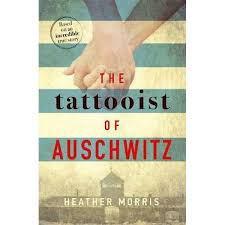
Book Cover Image: The Taster by V. S. Alexander
" data-orig-size="267,400" sizes="(max-width: 200px) 100vw, 200px" aperture="aperture" />Genre: Historical Fiction
Publication Date: 30 January 2018
Source: Publisher via Edelweiss
Synopsis from the Publisher:
“Amid the turbulence of World War II, a young German woman finds a precarious haven closer to the source of danger than she ever imagined—one that will propel her through the extremes of privilege and terror under Hitler’s dictatorship . . .
In early 1943, Magda Ritter’s parents send her to relatives in Bavaria, hoping to keep her safe from the Allied bombs strafing Berlin. Young German women are expected to do their duty—working for the Reich or marrying to produce strong, healthy children. After an interview with the civil service, Magda is assigned to the Berghof, Hitler’s mountain retreat. Only after weeks of training does she learn her assignment: she will be one of several young women tasting the Führer’s food, offering herself in sacrifice to keep him from being poisoned.
Perched high in the Bavarian Alps, the Berghof seems worlds away from the realities of battle. Though terrified at first, Magda gradually becomes used to her dangerous occupation—though she knows better than to voice her misgivings about the war. But her love for a conspirator within the SS, and her growing awareness of the Reich’s atrocities, draw Magda into a plot that will test her wits and loyalty in a quest for safety, freedom, and ultimately, vengeance.
Vividly written and ambitious in scope, The Taster examines the harrowing moral dilemmas of war in an emotional story filled with acts of extraordinary courage.”

Book Cover Image: The Tattooist of Auschwitz by Heather Morris
" data-orig-size="225,225" sizes="(max-width: 225px) 100vw, 225px" aperture="aperture" />Genre: Historical Fiction
Publication Date: 1 February 2018
Source: Publisher via NetGalley
Synopsis from the Publisher:
“Lale Sokolov is well-dressed, a charmer, a ladies’ man. He is also a Jew. On the first transport from Slovakia to Auschwitz in 1942, Lale immediately stands out to his fellow prisoners. In the camp, he is looked up to, looked out for, and put to work in the privileged position of Tätowierer – the tattooist – to mark his fellow prisoners, forever. One of them is a young woman, Gita, who steals his heart at first glance.
His life given new purpose, Lale does his best through the struggle and suffering to use his position for good.
This story, full of beauty and hope, is based on years of interviews author Heather Morris conducted with real-life Holocaust survivor and Auschwitz- Birkenau tattooist Ludwig (Lale) Sokolov. It is heart-wrenching, illuminating, and unforgettable.”
My Thoughts: Given the current trend of governments moving away from democracy around the world, the timing of two new novels about the Nazi regime during World War II feels particularly prescient. The two novels are nothing alike, told from two very different perspectives of Nazi Germany, but they both are important for modern readers. Not only do they serve as a warning cry to not only never forget what happened. They also serve as a reminder to remain diligent and aware in order to prevent something like that happening again.
V. S. Alexander‘s novel The Taster shows Nazi Germany from an insider’s perspective. Magda’s position as one of Hitler’s food tasters highlights his paranoia and his general fear of germs and murder plots. She provides readers with so much more though than just an intimate view of Hitler’s neuroses. Through Magda we see how well the Nazis hid the truth from the German citizens. We see the insidiousness of the Nazi regime and the unspoken fear with which they reigned. We see the reasons why the German people supported Hitler and considered him Germany’s savior and the blind faith they had that he would succeed. Lastly, we see that everyone had differing opinions as to the Nazis. Some supported him without question, others supported him with doubts, some feared his rule but did nothing, and others actively fought against the Nazi party using guerrilla tactics where possible.
Magda’s unique position affords readers an enticing look at all of this. Her story is as engaging as it is educational. The fact that it is based on the accounts of Hitler’s actual tasters makes it all the more compelling. Still, there is the feel that much of Magda’s story has been spiced up a bit. Her presence at certain scenes, and especially her friendship with Eva Braun, are most certainly a plot contrivance meant to give the story a bit more zest. This does not lessen some of the key points made – the growing desperation on the part of the Hitler party leaders, Hitler’s dichotomous nature, the increasing disconnect between the news reports about the war’s successful progression with nightly bombings and battles occurring ever closer to German soil. It does however mute their importance.
The Tattooist of Auschwitz is also based on a firsthand account, but unlike The Taster, there is no doubt that Lale’s story has no embellishments. It may be a novel, but it is nonfiction in the guise of fiction. This is an unusual narrative choice, but it makes Lale’s story easier to stomach. Anyone who entered the gates of Auschwitz in 1942 and survived the entire war and post-war chaos has lived through hell and has the stories to match. By filtering these stories through the medium of fiction, it softens the harsh edges of the truth and makes it more palatable.
Whereas desperation tinges Magda’s story, especially as the war draws to a close, hope and love are the defining themes of Lale’s story. This is a major distinction between the two novels and is as much a result of the different situations in which each of the two main characters existed as it is to their personalities. Magda was merely an observer, letting history happen around her, but Lale was an active participant in everything that happened to him. From the opening paragraph, we know that survival was Lale’s sole goal for whatever the Germans had in store for him. We see this in his manipulation of situations in his favor, no matter how it made him look to his fellow prisoners.
Moreover, he knew that in order to survive maintaining hope was essential, and we see him not only doing so for himself but finding reasons to help others remain hopeful. In addition, love literally changed his life. In a testament to the power to love, meeting his future wife shortly upon his arrival gave him the drive and reason to live, and the dream of marrying Gita as a free person allowed him to remain hopeful through the worst of what mankind can instill on others. In many ways, Lale’s story is as much of a love story as it is a personal observation of the horrors of war.
If The Taster is akin to a carousel ride, The Tattooist of Auschwitz is the most death-defying roller coaster. The former is entertaining, mild, and the type of story that allows you to remain an emotionless observer. The latter, though, is an emotional punch in the gut that demands you not only pay attention but become emotionally involved. Even with the filter smoothing the rough edges of horror, Lale’s story contains harsh realities that remain all the more disgusting because of their truth. For all of that, the layer of hope and his profound sense of love for Gita and for his fellow prisoners reminds you of the beauty of humanity and provides a fantastic juxtaposition for everything he experienced.












Related Stories
- Dark and eerie makes The Hazel Wood the perfect fantasy
- A tale of two feminist novels
- The Night Child should come with a warning label



